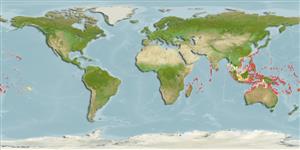Actinopterygii (ray-finned fishes) >
Perciformes (Perch-likes) >
Acanthuridae (Surgeonfishes, tangs, unicornfishes) > Acanthurinae
Etymology: Acanthurus: Greek, akantha = thorn + Greek, oura = tail (Ref. 45335).
Environment / Climate / Range
Ecology
Marine; brackish; reef-associated; depth range 1 - 30 m (Ref. 9710), usually 2 - 15 m (Ref. 27115). Tropical; 23°C - 28°C (Ref. 27115), preferred ?; 30°N - 24°S, 39°E - 143°W
Indo-Pacific: East Africa, including the Mascarene Islands (Ref. 37792) to the Tuamoto Islands, north to Ryukyu Islands, south to southern Great Barrier Reef. Not occurring in the Red Sea.
Length at first maturity / Size / Weight / Age
Maturity: Lm 18.4 range ? - ? cm
Max length : 40.0 cm TL male/unsexed; (Ref. 3145)
Dorsal
spines
(total): 9;
Dorsal
soft rays
(total): 25-28;
Anal
spines: 3;
Anal
soft rays: 23 - 26. Color in life dark brown without lines on body or spots on head (one phase is purplish grey); horizontal black band behind upper gill opening absent on juveniles <6 cm SL; elongate purple band may be present anterior to dorsal origin; caudal fin brown; outer third of pectoral fin pale. Species with gizzard-like stomach.
Occurs in clear lagoon and seaward reefs around isolated coral heads. Solitary or in small groups (Ref. 90102). Feeds on Prefers sandy bottoms of bays and lagoons rather than the coral reefs like most other Acanthuridae. The species is sometimes poisonous (Ref. 4795). Caught with nets (Ref. 30573).
Probably spawn in pairs (Ref. 240).
Randall, J.E., 1987. Three nomenclatorial changes in Indo-Pacific surgeonfishes (Acanthurinae). Pac. Sci. 41(1-4):54-61. (Ref. 1921)
IUCN Red List Status (Ref. 115185)
CITES (Ref. 94142)
Not Evaluated
Threat to humans
Poisonous to eat (Ref. 4795)
Human uses
Fisheries: commercial; aquarium: commercial
More information
ReferencesAquacultureAquaculture profileStrainsGeneticsAllele frequenciesHeritabilityDiseasesProcessingMass conversion
Tools
Special reports
Download XML
Internet sources
